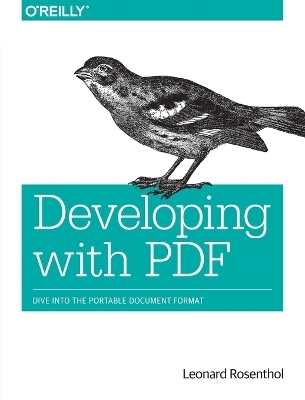
Developing with PDF
O'Reilly Media (Verlag)
978-1-4493-2791-0 (ISBN)
PDF is becoming the standard for digital documents worldwide, but it’s not easy to learn on your own. With capabilities that let you use a variety of images and text, embed audio and video, and provide links and navigation, there’s a lot to explore. This practical guide helps you understand how to work with PDF to construct your own documents, troubleshoot problems, and even build your own tools.
You’ll also find best practices for producing, manipulating, and consuming PDF documents. In addition, this highly approachable reference will help you navigate the official (and complex) ISO documentation.
- Learn how to combine PDF objects into a cohesive whole
- Use PDF’s imaging model to create vector and raster graphics
- Integrate text, and become familiar with fonts and glyphs
- Provide navigation within and between documents
- Use annotations to overlay or incorporate additional content
- Build interactive forms with the Widget annotation
- Embed related files such as multimedia, 3D content, and XML files
- Use optional content to enable non-printing graphics
- Tag content with HTML-like structures, including paragraphs and tables
Leonard Rosenthol is a Principal Scientist and PDF Architect for Adobe Systems, having been involved with PDF technology for more than 15 years. He represents Adobe on various international standards bodies including the ISO (where he is the Project Editor for PDF/A and PDF/E), W3C and ETSI/ESI (where he authored the PDF Electronic Signature standard, PAdES). Prior to re-joining Adobe in 2006, Leonard worked as the Director of Software Development for Appligent, and the Chief Innovation Officer for Apago, while also running the successful consulting business of PDF Sages. Before becoming involved in PDF, Leonard was the Director of Advanced Technology for Aladdin Systems and responsible for the development of the StuffIt line of products.
Chapter 1 PDF Syntax
PDF Objects
File Structure
Document Structure
What’s Next
Chapter 2 PDF Imaging Model
Content Streams
The Painter’s Model
Drawing Paths
Transformations
Basic Color
Marked Content Operators
Resources
External Graphic State
Basic Transparency
What’s Next
Chapter 3 Images
Raster Images
JPEG Images
Transparency and Images
Vector Images
What’s Next
Chapter 4 Text
Fonts
Text State
Drawing Text
Positioning Text
What’s Next
Chapter 5 Navigation
Destinations
Actions
Bookmarks or Outlines
What’s Next
Chapter 6 Annotations
Introduction
Appearance Streams
Markup Annotations
Non-Markup Annotations
What’s Next
Chapter 7 AcroForms
The Interactive Form Dictionary
The Field Dictionary
Field Classes
Form Actions
What’s Next
Chapter 8 Embedded Files
File Specifications
Ways to Embed Files
Collections
GoToE Actions
What’s Next
Chapter 9 Multimedia and 3D
Simple Media
Multimedia
3D
What’s Next
Chapter 10 Optional Content
Optional Content Groups
Optional Content Membership
Optional Content Configuration
Optional Content Properties
Marking Content as Optional
What’s Next
Chapter 11 Tagging and Structure
Structured PDF
Tagged PDFs
What’s Next
Chapter 12 Metadata
The Document Information Dictionary
Metadata Streams
What’s Next
Chapter 13 PDF Standards
PDF (ISO 32000)
PDF/X (ISO 15930)
PDF/A (ISO 19005)
PDF/E (ISO 24517)
PDF/VT (ISO 16612-2)
PDF/UA (ISO 14289)
Other PDF-Related Standards
Colophon
| Erscheint lt. Verlag | 26.11.2013 |
|---|---|
| Zusatzinfo | black & white illustrations |
| Verlagsort | Sebastopol |
| Sprache | englisch |
| Maße | 178 x 233 mm |
| Gewicht | 354 g |
| Einbandart | kartoniert |
| Themenwelt | Informatik ► Grafik / Design ► Desktop Publishing / Typographie |
| Informatik ► Web / Internet ► Web Design / Usability | |
| ISBN-10 | 1-4493-2791-5 / 1449327915 |
| ISBN-13 | 978-1-4493-2791-0 / 9781449327910 |
| Zustand | Neuware |
| Haben Sie eine Frage zum Produkt? |
aus dem Bereich


